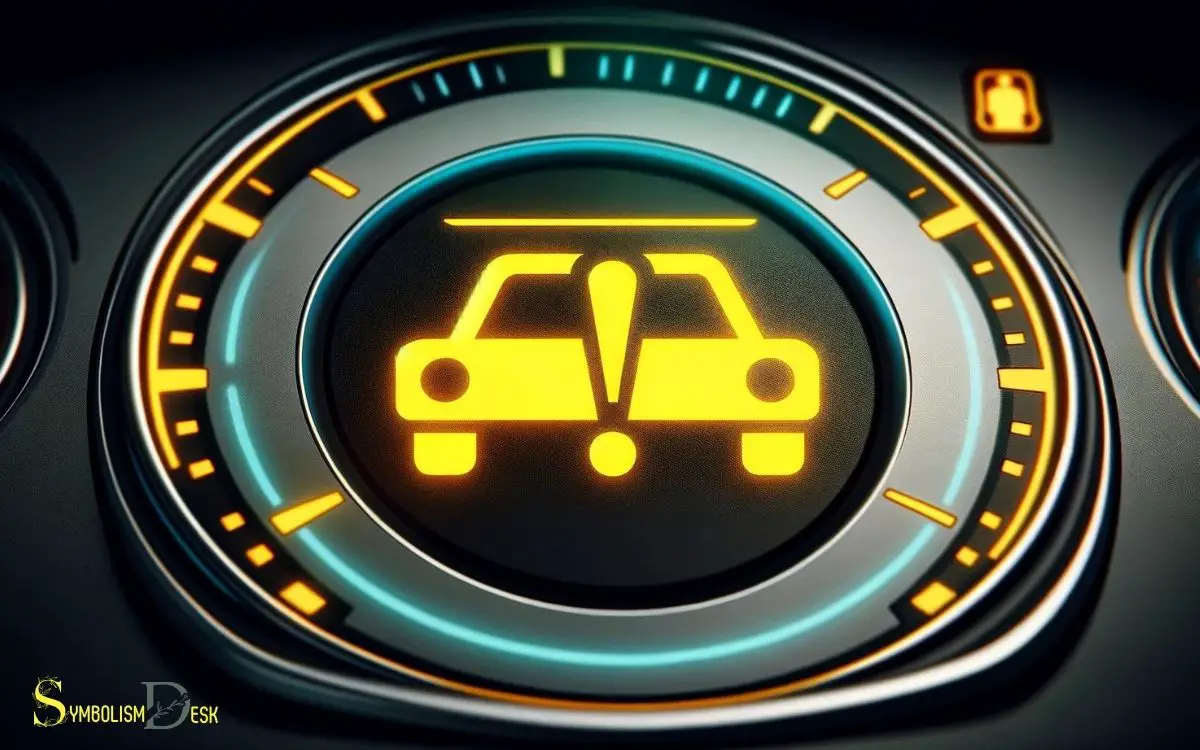Yellow Car Symbol With Exclamation Point: Issues!
The yellow car symbol with an exclamation point is a universal warning light indicating a range of potential issues with your vehicle that need immediate attention. It could represent a problem with your tires, brakes, engine, or other critical systems.
The yellow car symbol with an exclamation point is a general alert that something is amiss with the vehicle.
It can point to various issues, some of which include:
- Low tire pressure or a potential puncture
- Reduced fluid levels (brake, coolant, power steering, etc.)
- A malfunction within the braking system
- Engine or emission control system faults
- Electrical system irregularities
When this symbol illuminates, it is advisable to:
- Check your vehicle’s manual for specific guidance related to the warning
- Inspect tire pressure and condition
- Check fluid levels and top up if necessary
- Avoid heavy braking and high-speed driving if it pertains to brakes
- Have a professional mechanic diagnose the issue as soon as possible
Addressing the yellow exclamation warning promptly ensures vehicle safety and can save on costly repairs.

Key Takeaway
Understanding the Yellow Car Symbol with Exclamation Point
| Issue Category | Specific Problems | Immediate Actions |
|---|---|---|
| Tire Pressure | Low pressure, Puncture | Check and adjust pressure, repair tire |
| Fluid Levels | Low brake, coolant, power steering fluids | Check levels, refill as necessary |
| Braking System | Worn pads, Sensor faults | Inspect brakes, consult a professional |
| Engine/Emissions | Faulty components, Poor performance | Check engine light codes, see mechanic |
| Electrical System | Battery, Alternator issues | Test electrical components, get service |
Meaning of the Symbol
The yellow car symbol with an exclamation point typically indicates a problem or issue that requires attention in the vehicle. This warning light can mean a variety of things, depending on the make and model of the car, but it often relates to issues like low tire pressure, a handbrake not fully released, or other critical alerts. In some cases, it could denote a starting car system warning sign, signaling potential trouble with the ignition system or battery. It’s important to consult the vehicle’s manual or a professional mechanic to diagnose and address the issue promptly.
This warning light can signify various issues, such as low tire pressure, a malfunction in the braking system, or problems with the engine or transmission.
When this light appears on the dashboard, it is crucial for the driver to address the underlying problem promptly to avoid potential safety hazards or further damage to the vehicle.
Understanding the specific cause of this warning is essential for taking the appropriate measures to resolve it and ensure the vehicle’s proper functioning.
By diagnosing the possible causes of this warning light, drivers can effectively address the issue and maintain the safety and performance of their vehicle.
Possible Causes
When the yellow car symbol with an exclamation point illuminates on the dashboard, drivers should consider various potential causes that could trigger this warning.
One possible cause could be an issue with the vehicle’s brake system, such as low brake fluid or a problem with the anti-lock braking system (ABS).
Another potential cause might be related to the vehicle’s traction control system, indicating a loss of traction or a malfunction within the system.
Additionally, the symbol could be alerting the driver to a problem with the vehicle’s electronic stability control (ESC) system, which helps maintain stability and prevent skidding.
It’s important for drivers to promptly address the underlying issue when this warning light appears, as it could indicate a potential safety concern that requires attention from a qualified mechanic.
Importance of Immediate Action
When the yellow car symbol with an exclamation point appears, it indicates potential safety risks or issues that could lead to further damage if left unaddressed. Immediate action is crucial in order to prevent any potential hazards and further damage to the vehicle.
By addressing the underlying causes promptly, drivers can ensure the safety of both themselves and their vehicles.
Addressing Potential Safety Risks
An article on the ‘Yellow Car Symbol With Exclamation Point’ highlights the critical importance of taking immediate action to address potential safety risks.
When encountering this warning indicator, prompt attention is crucial to ensure the safety and functionality of the vehicle.
Addressing potential safety risks involves the following key steps:
- Check the Owner’s Manual: It provides valuable information about the warning symbol and recommended actions.
- Assess the Situation: Determine if it is safe to continue driving or if immediate action is necessary.
- Seek Professional Help: Contact a qualified mechanic or service center for a diagnostic assessment.
- Addressing the Issue: Take necessary steps to resolve the underlying problem causing the warning symbol.
- Regular Maintenance: Ensure routine maintenance to prevent potential safety risks in the future.
Preventing Further Damage
The vehicle owner’s immediate action is crucial in preventing further damage when the yellow car symbol with an exclamation point appears on their dashboard.
Ignoring this warning could lead to more severe issues and potentially costly repairs. When this symbol illuminates, it indicates a problem that needs prompt attention.
The vehicle owner should pull over to a safe location, turn off the engine, and consult the owner’s manual to understand the specific issue. In some cases, it may be necessary to call for roadside assistance or a mechanic.
By taking immediate action, the owner can prevent further damage to the vehicle and ensure their safety on the road. Timely response to warning indicators is essential to maintaining the vehicle’s performance and longevity.
Checking Fluid Levels
When it comes to maintaining a vehicle, checking fluid levels is essential. The key fluids to monitor include oil, coolant, brake, engine, transmission, and power-steering fluids.
Adhering to a regular maintenance schedule for fluid checks can help prevent potential issues and keep the vehicle running smoothly.
Oil, Coolant, Brake
To ensure proper vehicle maintenance, it is essential to regularly check the levels of oil, coolant, and brake fluid. Regular checks ensure that these vital fluids are at the appropriate levels, which is crucial for the smooth operation and longevity of the vehicle.
Here are some important points to consider when checking the fluid levels:
- Oil: Check the oil level using the dipstick, ensuring it falls within the recommended range.
- Coolant: Inspect the coolant level in the reservoir and ensure it is between the minimum and maximum markings.
- Brake Fluid: Verify that the brake fluid level is within the specified range indicated on the reservoir.
- Quality: Assess the condition and quality of the fluids for any signs of contamination or deterioration.
- Top-Up: If any fluid levels are low, top them up with the recommended fluid type to the correct level.
Engine, Transmission, Power-Steering
Upon starting the vehicle, drivers should routinely check for any leaks or seepage from the engine, transmission, and power-steering systems. It is essential to maintain proper fluid levels in these systems to ensure the smooth operation of the vehicle.
Start by locating the dipsticks or reservoirs for the engine oil, transmission fluid, and power-steering fluid. Remove the dipsticks, wipe them clean, reinsert, and then pull them out again to check the fluid levels.
If any of the fluids appear low, it may indicate a leak or a need for a top-up. Additionally, inspect the areas around these systems for any signs of leakage, such as oil spots or wetness.
Addressing any fluid leaks promptly can prevent potential damage and costly repairs to the engine, transmission, and power-steering components.
Regular Maintenance Schedule
The regular maintenance schedule for checking fluid levels in a yellow car with an exclamation point symbol is crucial for ensuring optimal vehicle performance and longevity.
Here are some key points to consider:
- Engine Oil: Regularly check and maintain the engine oil level to ensure proper lubrication.
- Coolant: Monitor the coolant level and top it up as needed to prevent overheating.
- Brake Fluid: Regularly inspect the brake fluid level to ensure efficient braking performance.
- Transmission Fluid: Check the transmission fluid to maintain smooth gear shifts and prevent damage.
- Power Steering Fluid: Monitor the power steering fluid level to ensure easy steering control.
Maintaining proper fluid levels is essential for preserving the overall health of the vehicle and preventing potential issues.
Tire Pressure Check
When the yellow car symbol with an exclamation point appears on the dashboard, it indicates the need for a tire pressure check. Proper tire pressure is crucial for vehicle safety, fuel efficiency, and tire longevity.
To conduct a tire pressure check, one should use a tire pressure gauge to measure the air pressure in each tire, including the spare.
The recommended pressure levels can usually be found in the owner’s manual or on a sticker inside the driver’s side door. If the tire pressure is low, it should be promptly inflated to the correct PSI (pounds per square inch).
It’s important to note that tire pressure should be checked regularly, ideally once a month, and before long trips. Maintaining adequate tire pressure ensures optimal vehicle performance and safety.
Electrical System Inspection
Inspecting the electrical system ensures the proper functioning of crucial vehicle components. This inspection involves checking various elements to detect any potential issues that could affect the vehicle’s electrical system.
The following aspects are typically examined during an electrical system inspection:
- Battery: The battery is tested to ensure it is holding a charge and functioning properly.
- Wiring: The wiring is inspected for any signs of damage, corrosion, or loose connections.
- Alternator: The alternator’s output is checked to verify that it is charging the battery correctly.
- Starter: The starter is examined to ensure it is engaging and disengaging as required.
- Lights and indicators: All lights and electrical indicators are tested to confirm they are operating correctly.
Regular electrical system inspections are essential for maintaining a reliable and safe vehicle.
Seeking Professional Help
An owner should seek professional help promptly if their yellow car symbol with an exclamation point illuminates on the dashboard. Ignoring this warning could lead to serious safety hazards or potential damage to the vehicle.
Below is a table outlining possible reasons for the illuminated symbol and the recommended actions:
| Issue | Recommended Action |
|---|---|
| Low tire pressure | Check tire pressure and inflate to the recommended level. |
| Brake system malfunction | Have the brake system inspected by a qualified mechanic. |
| Transmission issues | Seek immediate diagnosis and repair from a certified technician. |
| Engine problems | Schedule a diagnostic check to identify and address the issue. |
| Electronic stability control fault | Visit a professional to diagnose and fix the stability control system. |
Seeking professional assistance when the yellow exclamation symbol appears is crucial for ensuring vehicle safety and preventing further damage.
Conclusion
When you see the yellow car symbol with an exclamation point, don’t ignore it. It’s a red flag that something may be wrong with your vehicle. Remember, a stitch in time saves nine, so take immediate action to prevent further damage.
Whether it’s checking fluid levels, tire pressure, or seeking professional help, addressing the issue promptly can save you time and money in the long run. Stay safe on the road!






